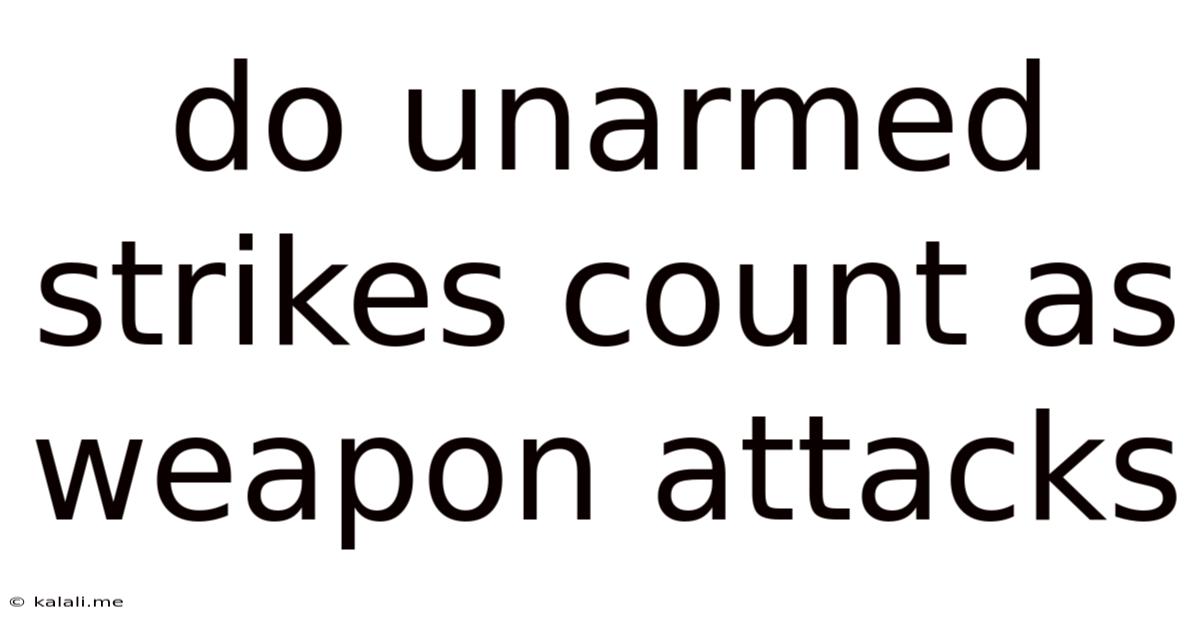Do Unarmed Strikes Count As Weapon Attacks
Kalali
Jun 10, 2025 · 3 min read

Table of Contents
Do Unarmed Strikes Count as Weapon Attacks? A Comprehensive Look at Martial Arts and Self-Defense
The question of whether unarmed strikes count as weapon attacks is a complex one, blurring the lines between self-defense, assault, and legal definitions. The answer hinges on several factors, including the context of the strike, the intent behind it, and the jurisdiction in which the incident occurs. This article explores the nuances of this question, examining the legal considerations and the implications for martial arts practitioners and self-defense situations.
Understanding the Legal Distinction
Legally, the definition of a "weapon" varies significantly. While a knife or firearm clearly qualifies, the classification of unarmed strikes is much more nuanced. Many jurisdictions consider an object to be a weapon if it's used to inflict harm, regardless of its intended purpose. This means a seemingly innocuous object like a belt or even a fist can become a weapon in the context of an assault. The key factor is the intent and the manner in which the strike is delivered. A simple push is drastically different from a forceful punch to the face.
The Role of Intent
The intent behind the strike heavily influences its legal classification. Was the strike a preemptive defensive action, a retaliatory move, or an act of aggression? A self-defense claim often hinges on demonstrating that the force used was proportional to the threat faced. An unarmed strike, even if resulting in injury, may be considered justifiable self-defense if the attacker was facing imminent danger and had no other reasonable means of escape. Conversely, a deliberate, brutal attack with fists or feet, aiming for vulnerable areas, would likely be classified as an assault, regardless of the lack of a traditional weapon.
Severity of Injury and Context
The severity of the injury inflicted also plays a significant role. A light tap is vastly different from a blow causing a concussion. Similarly, the context of the situation greatly influences the legal outcome. A street fight is treated differently than a self-defense scenario in one's own home. Martial arts training further complicates the issue. A trained martial artist using techniques learned in class might be subject to greater scrutiny, as their actions are likely to be more precise and potentially more damaging than those of someone without training.
Martial Arts and Self-Defense Training:
Martial arts training emphasizes techniques that can be used for self-defense. However, the application of these techniques in a real-world self-defense scenario requires careful consideration. While learning to defend oneself is crucial, it's essential to understand the legal boundaries. Overuse of force, even with unarmed strikes, can lead to legal repercussions. Proper training often includes instruction on de-escalation techniques and understanding the limits of self-defense.
Examples and Case Studies:
While specific case studies are beyond the scope of this article (due to the varying legal jurisdictions and fact-specific nature of such cases), hypothetical scenarios can illustrate the point:
- Scenario 1: Someone defending themselves against a knife attack uses a series of punches and kicks to disarm and subdue their attacker. This might be deemed justifiable self-defense.
- Scenario 2: Someone initiates a fight and uses a series of well-executed punches and kicks to inflict significant injuries on their opponent. This is unlikely to be considered self-defense and could lead to assault charges.
Conclusion:
In conclusion, whether unarmed strikes constitute weapon attacks depends on a multitude of factors. The intent, the severity of the injury, the context of the situation, and the legal jurisdiction all play vital roles in determining the legal ramifications. While unarmed strikes can be used for self-defense, it's crucial to act proportionally, understand legal limitations, and always prioritize de-escalation whenever possible. If involved in a self-defense situation, seeking legal counsel is paramount.
Latest Posts
Latest Posts
-
How Old Is Someone Born In 1992
Jul 01, 2025
-
How Many Grams Is In A Pint
Jul 01, 2025
-
Lyrics To The Song Stand By Donnie Mcclurkin
Jul 01, 2025
-
How Much Is 3 Quarts Of Water
Jul 01, 2025
-
How Many Cups Is 1 Pound Of Pasta
Jul 01, 2025
Related Post
Thank you for visiting our website which covers about Do Unarmed Strikes Count As Weapon Attacks . We hope the information provided has been useful to you. Feel free to contact us if you have any questions or need further assistance. See you next time and don't miss to bookmark.